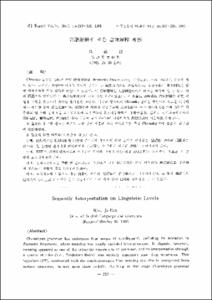유리피판 33례 분석
- Alternative Title
- An analysis of 33 consecutive cases of free flaps
- Abstract
- 31 patients(26 males and 5 females) aged 14 to 70 years underwent 33 microvascular free tissue transfers from April 1990 to July 1992(27 months) in the plastic surgical unit in Asan Medical center. We evaluated our cases based on the diagnosis, anatomic locations of recipient and donor site, morbidity and results.
Among 24 cases in head and neck regoin, 19 cases were tumors and four were acquired deformities, and one was a congenital hemifacial microsomia. 6 cases were reconstructions of extremities and one for a radiation ulcer in the sacral area.
The selection of donor site was based upon the location of defect and the volume of tissue required ; the forearm free flap was used in 11 cases, the rectus abdominis in 5, the groin in 4, the latissimus dorsi in 3, the parietotemporalis fascia in 3, the jejunum in 2, and the occipital scalp, the first toe web space, the serratus anterior, the dorsails pedis and the omentum were in one respectively.
The average postoperative hospital day was 26.6 days and all complications were reversible with hematoma removal and conservative treatment. The free tissue transfers were primarily indicated in all patients in our series and there was no flap failure.
A free flap is not only the most expedient method of reconstruction but also either the most reliable or the only available one in the majority of our cases.
31 patients(26 males and 5 females) aged 14 to 70 years underwent 33 microvascular free tissue transfers from April 1990 to July 1992(27 months) in the plastic surgical unit in Asan Medical center. We evaluated our cases based on the diagnosis, anatomic locations of recipient and donor site, morbidity and results.
Among 24 cases in head and neck regoin, 19 cases were tumors and four were acquired deformities, and one was a congenital hemifacial microsomia. 6 cases were reconstructions of extremities and one for a radiation ulcer in the sacral area.
The selection of donor site was based upon the location of defect and the volume of tissue required ; the forearm free flap was used in 11 cases, the rectus abdominis in 5, the groin in 4, the latissimus dorsi in 3, the parietotemporalis fascia in 3, the jejunum in 2, and the occipital scalp, the first toe web space, the serratus anterior, the dorsails pedis and the omentum were in one respectively.
The average postoperative hospital day was 26.6 days and all complications were reversible with hematoma removal and conservative treatment. The free tissue transfers were primarily indicated in all patients in our series and there was no flap failure.
A free flap is not only the most expedient method of reconstruction but also either the most reliable or the only available one in the majority of our cases.
- Issued Date
- 1992
- Type
- Research Laboratory
- Alternative Author(s)
- Koh, KyungSuck; Yoon, KunChul
- Publisher
- 울산의대학술지
- Language
- kor
- Rights
- 울산대학교 저작물은 저작권에 의해 보호받습니다.
- Citation Volume
- 1
- Citation Number
- 1
- Citation Start Page
- 130
- Citation End Page
- 140
- Appears in Collections:
- Research Laboratory > The ULSAN university medical journal
- 파일 목록
-
-
Download
 000002024424.pdf
기타 데이터 / 908.22 kB / Adobe PDF
000002024424.pdf
기타 데이터 / 908.22 kB / Adobe PDF
-
Items in Repository are protected by copyright, with all rights reserved, unless otherwise indicated.